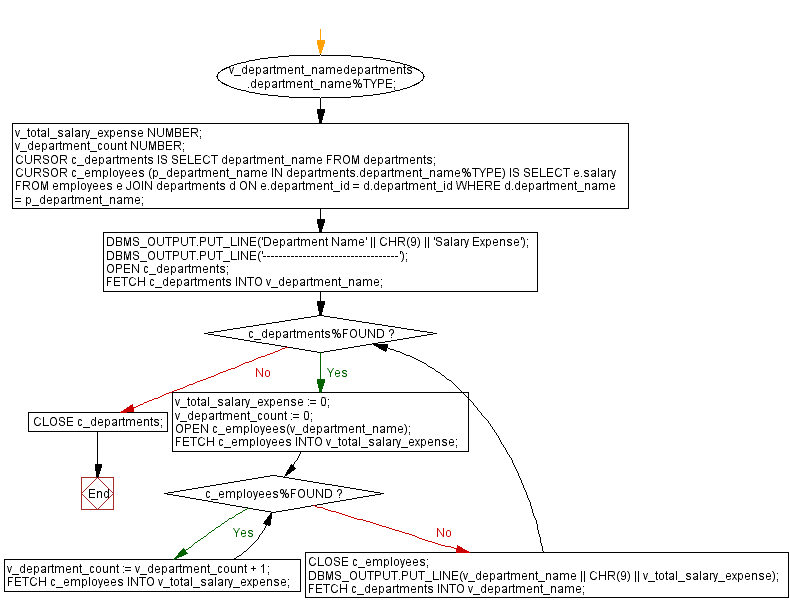PL/SQL program: Department-wise total salary expense
PL/SQL While Loop: Exercise-14 with Solution
Write a PL/SQL program to display the total salary expense for each department. Return depart name and salary expenses in tabular form.
Sample Solution:
Table: employees
employee_id integer first_name varchar(25) last_name varchar(25) email archar(25) phone_number varchar(15) hire_date date job_id varchar(25) salary integer commission_pct decimal(5,2) manager_id integer department_id integer
Table: departments
department_id integer department_name varchar(25) manager_id integer location_id integer
PL/SQL Code:
DECLARE
v_department_namedepartments.department_name%TYPE;
v_total_salary_expense NUMBER;
v_department_count NUMBER;
CURSOR c_departments IS
SELECT department_name
FROM departments;
CURSOR c_employees (p_department_name IN departments.department_name%TYPE) IS
SELECT e.salary
FROM employees e
JOIN departments d ON e.department_id = d.department_id
WHERE d.department_name = p_department_name;
BEGIN
DBMS_OUTPUT.PUT_LINE('Department Name' || CHR(9) || 'Salary Expense');
DBMS_OUTPUT.PUT_LINE('----------------------------------');
OPEN c_departments;
FETCH c_departments INTO v_department_name;
WHILE c_departments%FOUND LOOP
v_total_salary_expense := 0;
v_department_count := 0;
OPEN c_employees(v_department_name);
FETCH c_employees INTO v_total_salary_expense;
WHILE c_employees%FOUND LOOP
v_department_count := v_department_count + 1;
FETCH c_employees INTO v_total_salary_expense;
END LOOP;
CLOSE c_employees;
DBMS_OUTPUT.PUT_LINE(v_department_name || CHR(9) || v_total_salary_expense);
FETCH c_departments INTO v_department_name;
END LOOP;
CLOSE c_departments;
END;
/
Sample Output:
Department Name Salary Expense ---------------------------------- Administration 4400 Marketing 6000 Purchasing 2500 Human Resources 6500 Shipping 3000 IT 4200 Public Relation 10000 Sales 6200 Executive 17000 Finance 6900 Accounting 8300 Treasury 0 Corporate Tax 0 Control AndCre 0 Shareholder Ser 0 Benefits 0 Manufacturing 0 Construction 0 Contracting 0 Operations 0 IT Support 0 .....
Explanation:
The said code in Oracle's PL/SQL that calculates the total salary expense by summing up the salaries of employees in each department and displays the results.
The variables v_department_name, v_total_salary_expense, and v_department_count are declared to store department names, total salary expense, and a counter for employees in each department.
The two cursors c_departments that fetchs the department names from the departments table, and c_employees that fetch the salaries of employees based on the department name are defines.
A loop that executes as long as there are more departments to process on c_departments cursor that fetches the department names. The variables v_total_salary_expense and v_department_count initialized to zero for each department.
The cursor c_employees opens with the current v_department_name as a parameter and fetches the salary of the first employee into v_total_salary_expense and continues fetching until process all employees in the department.
Increments the v_department_count to keep track of the number of employees.
The DBMS_OUTPUT.PUT_LINE statement displays the department name and the corresponding total salary expense.
Flowchart:

Go to:
PREV : Average salary by job title.
NEXT : Count Employees in Each Department.
Improve this sample solution and post your code through Disqus
What is the difficulty level of this exercise?
